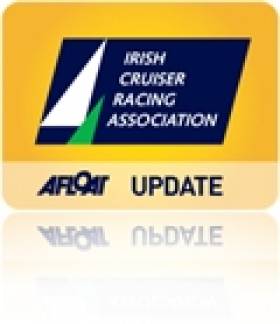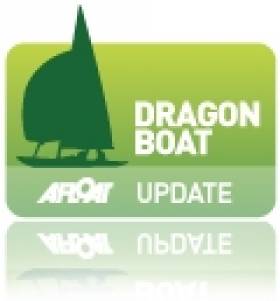Displaying items by tag: Royal Irish Yacht Club
#cruiserracing – Arrangements are being finalised to provide top class racing on the water to decide National Champions in all divisions at this year's ICRA Nationals that take place at a prime time in the season from 13th to 15th June in the Royal Irish Yacht Club. This, say organisers, will be the major cruiser racing event on the east coast for 2014 and already there is a push on to break the record of 125 entries for the championships.
There is currently a fine high calibre fleet of 42 boats already entered from all around the country and across the Irish Sea.
Also with the emphasis by ICRA to look at new divisional break-points in an effort to provide great racing for all, Divisions 1 & 2, Divisions 2 & 3 and Divisions 3 & 4 might be looking a bit different!
Racing will be under Endorsed IRC and Progressive ECHO. There will be a Club Team trophy and new trophy for boat with best aggregate score in Irish IRC's and Welsh IRC's.
In Division 0, Jump Juice is making a welcome return to challenge Crazy Horse and WOW with Tsunami also in the mix. Still awaiting Scottish First 40's to enter together with the challengers from Wales! With Antix away with other Commodores' Cup boats, it leaves the division ready to crown a new champion.
As is, Division 1 has a really exciting line up developing with Paul O Higgins Rockabill taking on a clutch of 7 J109's including previous Champion Pat Kelly's Storm, Liam Shanahan's Ruth, John Hall's Something Else, John Maybury's Joker II, visitor Peter Dunlop's Mojito, Stephen Tudor's ISORA Champion Sgrech, Rob O'Connell's A35 Fool's Gold and the crewed-up Fox & Sox with yet more challengers to enter.
Division 2 is also building nicely with Nigel Bigg's Checkmate lining up against the Corby 25's Smile Rob Allen and Noonan Chambers Impetuous and well-travelled Shane Strathan and Trudy O'Leary's Slack Alice. Adding to all these the hot half Tonners King One, The Big Picture and visitor Movie Star Blue.
Division 3 will see the Quarter Tonners Cri-Cri Paul Colton and Supernova of Timbs, Monaghan, Costello and McStay form the basis of what no doubt will also be a very competitive fleet. Also into this will be Cartoon, Quest, Sigma 33 White Mischief, J24's Jebus and Euro Carparks.
Division 4 will also be competitive with local boats of Asterix, Gung Ho & Taiscealai, UpD8 and Saki to the fore.
For Non Spinnaker Boats,The Corinthian Cup provides trophies and prizes in both IRC and ECHO and should see a good fleet taking part. Leading contenders Dave Shanahan's Warrior, Howard Knotts Calypso, Steve Hayes Pure Magic, Sean O'Regan's Vespucci and Philip Smith's Just Jasmin (DBSC's Spring Chicken winner) are among the early entries.
This year's ICRA Nationals are building momentum and looks forward to building on the success of superb previous events worthy of a true National Championship and to celebrate producing top-class National Champions! The 25% discount entry date is 14th April so get your entries in now.
#yachtclubs – A new Dun Laoghaire-based political party, People United in Republican Endeavour (PURE), has launched its campaign for the forthcoming Local Government Elections with demands for changes in the style and names of the leading yacht clubs, both in Dun Laoghaire and throughout Ireland reports W M Nixon.
Introducing a Policy Document on behalf of PURE, the new party's spokesman Mr Hugh Mannity stated: "It makes me suffer to see these unfortunate people, the members of the Dun Laoghaire waterfront yacht clubs, being forced into aping the airs and graces of their former colonial oppressors".
"Despite the imminence of a State Visit to the Queen of England by the President of Ireland, we who are PURE demand that all vestiges of former royal dominance and patronage be removed entirely from every organisation, building and boat in Ireland".
However, Mr Mannity insisted that the changeover would be effected with a minimum of expense. "We know that perhaps the most costly aspect of this fresh new initiative will be in the changing of signs, letterheads and so forth," he said. "In the case of yachts, there would be additional expense in changing the lettering on the hulls denoting the club to which the owner belongs."
The Research Department in PURE has been burning the midnight oil, Mr Mannity claimed, in order to minimise expense, or indeed make it unnecessary altogether. "Thanks to our far-seeing think tank," he said, "the initials for the Royal Irish Yacht Club will stay exactly the same, only now it will be known as the Republic of Ireland Yacht Club".
"Equally, the Royal St George Yacht Club will retain its initials, but the title of the club will be changed to the Religious St George Yacht Club. This is because we in PURE find it doubly offensive that a leading yacht club should have a royal title combined with a political overtone which completely ignores the underlying theme of the sanctity of St George. So we hope to put the holiness back into the club for the good of its members"
"A problem arises with the Royal Alfred Yacht Club. We find it offensive that it should commemorate a now unknown son of the ruthless Queen Empress Victoria. Thus we have decided that, while it should retain its present initials, it should henceforth be known as the Real Alfie Yacht Club, named in honour of the much-loved long-term Lord Mayor of Dublin Alfie Byrne, who was also world-renowned for his pioneering work in moustache research and manipulation."
Mr Mannity continued by stating that his grouping would show its even-handedness by insisting on a change in the title of the National Yacht Club. "While we laud this fine club's lack of any royal associations in its name," he said, "we are concerned that these days too many organisations, in sailing as elsewhere, insist on having "National" in their title, thereby rendering it meaningless. Thus we will expect the NYC to become the TNYC – the True National Yacht Club. We appreciate that this will cause the members some expense, but our Field Researchers who regularly walk Dun Laoghaire's East Pier with their whippets tell us that, judging by the boats stored in the club's forecourt, the members could well afford to lay out the money on a 'T'."
When questioned about PURE's intentions regarding the Royal Cork Yacht Club, Mr Mannity said he did foresee a special problem. The Republic of Cork already existed within the Rebel County, and re-naming the club would be a matter of whether or not it became the Republic of Cork Yacht Club, or the Rebel County Yacht Club. "There could well be blood in the streets over that one" he admitted.
However, in order to show the depth of research undertaken by PURE's think tank on this entire matter, Mr Mannity pointed outthat not many people were aware that within the Royal Cork YC's present structure, the old Royal Munster Yacht Club still existed, and was recognised by the role of Commodore in the RCYC officer board, along with the Admiral.
"We feel that too many problems would be created by trying to establish a Republic of Munster in order to facilitate the existence of a Republic of Munster Yacht Club. Thus we have decided it should be re-titled the Province of Munster Yacht Club. We realise that this will necessitate a small change in the initial letter. But where some traditionalists still have RMYC across the sterns of their boat, we would point out that changing it to PMYC would only involve painting out one little leg of the letter 'R'. However, to show our goodwill, a small phial of white paint will be provided to owners to facilitate the change. We realise that this will only work with white boats. But the Irish taxpayer cannot be expected to fork out hard-earned cash for the awkward minority who insist on parading about on the ocean in boats coloured Mediterranean Blue or Sunset Red or whatever, when any civilised person knows that all proper yachts are white".
In concluding his PURE statement, Mr Mannity admitted that the root of the problem in creating a Republic of Munster lay in the continuing existence of the Kingdom of Kerry. "We're not crazy" he asserted. "We know that trying to subsume Kerry into a new Republic in a combination with Cork would be a step too far".
"Nevertheless we feel strongly that it is time and more for the good people of Kerry to reconsider their claims to the status of being a monarchy. Thus we propose what we feel will be a real vote getter. We plan to re-position Kerry as a Duchy. And plans are well advanced to request a noted KiIgarvan family to become the hereditary Dukes of Kerry. We feel sure that this brilliant innovative idea will be a surefire runner"
Tactics & Strategy for Sailing Class to Be Held at Royal Irish Yacht Club
#riyc – The Royal Irish Yacht Club (RIYC) in Dun Laoghaire is staging a tactics & strategy class in advance of the forthcoming season.
The sessions will be spread over four Tuesday nights in March (4th, 11th, 18th and 25th) at the RIYC.
The sessions by sailing coach Maurice O'Connell will start at 7pm and finish at 10pm with a 15 minute coffee break.
The cost is €50.00 and its possible to book online here or by email to [email protected]
Topics will inlcude
1. Pre-race planning
· weather
· current
· expected windshifts
· competition
2. Pre-start analysis
· line bias
· bias vs first leg strategy
· bias / strategy vs. boats types (in mixed fleet)
· rules at start line
3. Upwind
· lane management
· windshifts
· cross or dip?
· laylines
· rules between boats meeting and at windward mar
4. Reaching
· high or low?
· GPS
· rules (clear astern, windward leeward, entering the "zone")
5. Downwind tactics
· gybe set or bear away set?
· who is steering and what wind angle to sail?
· gybe on the lifts but where are they?
· lane management
· rules when boats meet
6. Finishing – which end?
Has Dun Laoghaire Lost the Plot?
#dlharbour – Dun Laoghaire's waterfront area and harbour is a hotbed of development and proposed projects. W M Nixon takes an outsider's view of what might be happening around Ireland's biggest sailing centre.
Your heart would go out to Dun Laoghaire. The perceptions which emerge from proposals for developments and new businesses along the waterfront definitely don't chime at all with the image of a place which once was known as Kingstown, and has its origins in the heights of gentility and middle class refinement.
What are we folk from other ports to make of it all? We find sailing in through the entrance to savour Dun Laoghaire harbour's unique style a wonderful experience. There is nowhere quite like it, not just in Ireland, but anywhere else in the world. Yet rumours fly around about changes which could seriously impair the special character of the place. What are those of us who may not have the inside track on the true nature of actual and anticipated developments along the waterfront to make of it all?
Not to pull the punches, it seems that the Dun Laoghaire waterfront area is going to have an enlarged halting site for the Travelling community down towards the west pier. It's going to have an "urban beach" resort amenity for the sort of people who use such places within the harbour on the inner end of the east pier, thereby blocking off a very useful berthing space. And it's going to have the Dublin area's first Wetherspoon's super-pub right bang in the middle of the harbourside.
Set against Dun Laoghaire history and the elegant appearance of its better buildings, this would all seem bad enough. But that is to ignore the most enormous elephant in the room. This is the new public library, which has been put up with astonishing speed to block out much of the sea view from the Royal Marine Hotel. It towers over the entire waterfront with a prow which suggests that at last Ireland has her first aircraft carrier. But unfortunately for any strategic purposes and rapid peace-keeping in distant parts of the world, it happens to be very landbound in the midst of mostly pleasant smaller buildings which now seem utterly dwarfed.

It's behind you!!!........ The new Dun Laoghaire library looms over everything on the waterfront. Yet if you're in the National YC (foreground) and looking out to sea, you don't know it's there. Photo: W M Nixon
It would indeed be wonderful if it were an aircraft carrier and could put to sea and leave the town to nurture something of its own true character. But instead we have to learn to live with it while wondering what it's all about, though in fairness it should be mentioned that the first notions of it were to provide a structure to match the sky-scraping Daniel Liebeskind building (remember that?) which once upon a time was planned for the Carlisle Pier just across the way.
But if this is indeed a public library, then we can only conclude that the good people of Dun Laoghaire must do an awful lot of reading, for it's HUGE. And we can only fear that if they read with the assiduity this building suggests, then they'll have neither time nor energy for anything else, not even the seagoing pursuits which the possession of one of the finest artificial harbours in the world should encourage.
From Dun Laoghaire's traditional promenading area of the East Pier, the new library building towers in particular over the National Yacht Club. Of course, if you're in that most hospitable club and looking out to sea, you're blissfully unaware of this enormous presence behind you. But the effect on people coming in from seaward is distinctly oppressive - it's like that giant black space craft which hovered over New York in the movie Independence Day.

Dun Laoghaire in the rare ould times, when you'd a real sea view from the Royal Marine Hotel, and from the pier could admire that splendid establishment in all its glory. Photo courtesy NYC.
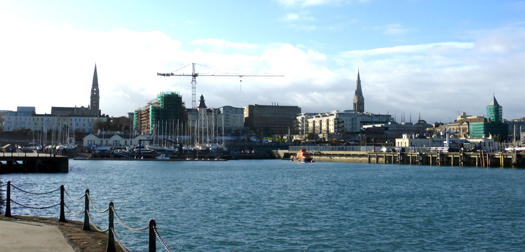
The same section of waterfront today. Is this progress? Photo: W M Nixon
Until this thing appeared, there were still some relics of ould decency and architectural harmony along the Dun Laoghaire waterfront and the streets immediately behind it. Any significant building is a statement in itself, so we're entitled to look at buildings as they are, and respond to them. The central gem of the waterfront is the railway station, designed by John Skipton Mulvany. It's a perfect little jewel of neo-classical design, and to my mind makes a much pleasanter architectural statement than that other exercise in classical work, the Casino at Marino, which was fussily built as an architectural exercise, whereas Dun Laoghaire station is both functional and beautiful, well fulfilling its contemporary role as a stylish restaurant.
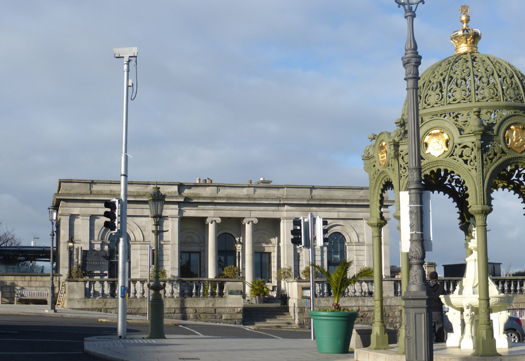
Dun Laoghaire's Mulvany-designed station is a gem. Photo: W M Nixon
Dun Laoghaire did very well out of John Skipton Mulvany, as in 1851 he created the design for the Royal Irish Yacht Club building. In terms of Irish history, few buildings are so significant in the very fact and timing of their construction. Originally founded in 1831, the Royal Irish had been overshadowed by its brasher younger sister, the Royal St George YC founded 1838. While the George developed rapidly as the exclusive preserve of the land-owning classes and the most prosperous Protestant business magnates – the offspring of Cromwellian land-grabbers and the Jamesons and Guinnesses, in other words – the RIYC, as a club with some of the older traditions in its makeup, went into a decline which was accelerated by the grievous effects of the Great Famine from 1845 onwards.
Thus when a meeting of several RIYC members – their numbers including Daniel O'Connell the Liberator - was held in a Dublin hotel on 4th July 1846 (American Independence Day by design, one presumes), it was in the hope that the club could be revived as an expression of faith in the future, and they agreed that a new landmark building on the waterfront would be the key to this.
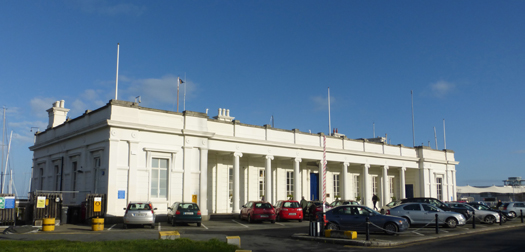
The landward side of the Royal Irish YC. With the undeveloped nature of the waterfront, the architect had to design a building which presented a proper facade on all fronts. Photo W M Nixon
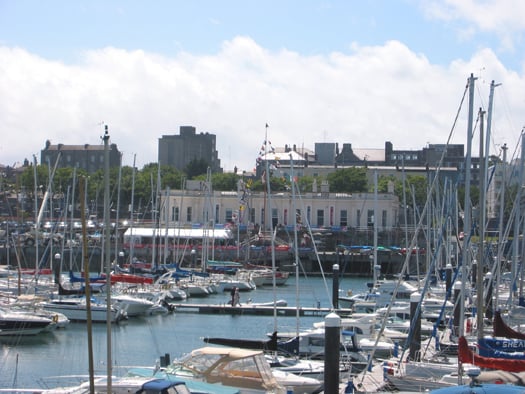
The Royal Irish YC seen across the marina. Built 1851, it is the world's oldest complete purpose-designed yacht club building. Photo: W M Nixon
So in responding to the RIYC's impressive neo-classical pavilion on the harbour, we are looking at both the world's first complete purpose-built yacht club house, and the very symbol of a nation beginning the long road to recovery from both the Famine and centuries of conquest and despoliation.
Along the waterfront, the Royal St George clubhouse by contrast was built through frequent expansions, but as Mulvany was also involved in some of the stages, it has a fine sense of completeness despite its several creators in different eras. Facing up to the challenge of matching these two classical buildings on the waterfront to the west was clearly an insuperable task, so when the National Yacht Club came into being as the Edward Yacht Club in 1870, it went for a much more under-stated architectural style. There's something attractively of the shooting and fishing lodge of the west of Ireland about it, it seems modest by comparison with the other two clubhouses, yet it's surprisingly roomy and stylish within.

Although it was built in several stages, today the Royal St George YC presents a complete appearance, and it preserves its sense of identity despite the encroachment of much taller modern buildings nearby. Photo: David O'Brien
All three of the big waterfront clubhouses are immaculately maintained and each brings its own injection of vitality – and substantial employment – to Dun Laoghaire. And the town in turn has developed in concert with the growth of maritime activity, and the increased communication with Dublin brought about by the historic railway (which was opened in 1834) and frequent road improvements, while summertime excursion steamers sailed to the harbour from Dublin port.
Some would compare the stylish seaside town for Dublin which tried to develop at Dun Laoghaire with Brighton in its relationship with London. But Brighton was purely a seaside resort in which the recent marina is an add-on, it's not a harbour which is central to the place. Dun Laoghaire by contrast is all about the harbour. There was virtually nothing there until this vast asylum and ferry harbour for large vessels (that was its sole original purpose) was built on a totally empty bit of coastline eastward of the old Dunleary harbour, a shallow tidal inlet which it enclosed and whose existence is remembered in the area's local name The Gut.
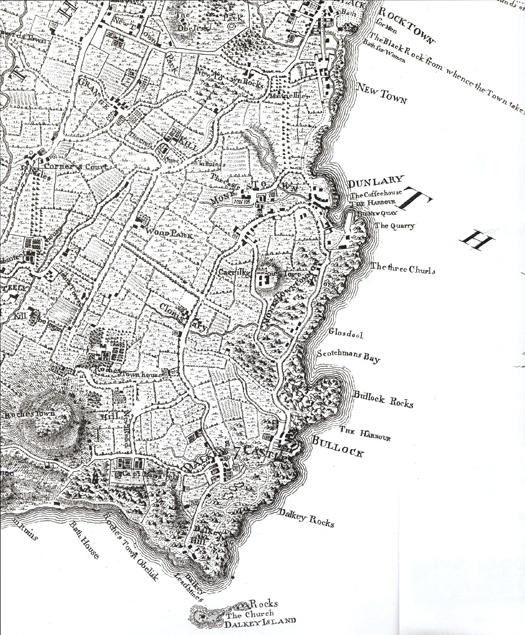
The coast at Dun Laoghaire before the harbour was built. The harbour of Old Dunleary, in the area still known as The Gut, was a shallow creek in the southwest corner of the new harbour.

First plan for the new harbour in 1817. The entrance was made wider in the finished version, and the West Pier was built further west to enclose the Old Dunleary harbour
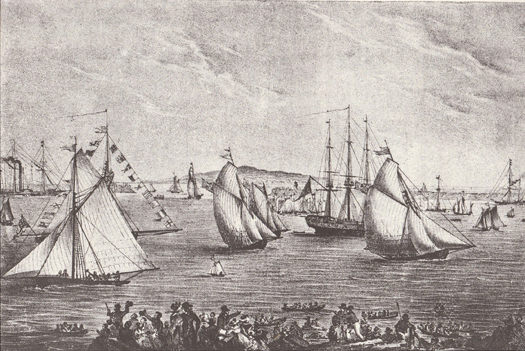
The first regatta in the new harbour was sailed on July 22nd 1828, and was won by Liberty (on right, 39 tons, owner Lord Errol) from Medora (45 tons, owner Mr Kelly). The Royal Irish YC emerged in 1831 from this event.

The yachtsman's Dun Laoghaire today, as shown in the ICC Sailing Directions. Courtesy Irish Cruising Club
Thus it may be stretching it a bit, but the most telling comparison for Dun Laoghaire's aspirations might well be Trieste on the Adriatic. In the glory days of the Austro-Hungarian Empire, Trieste was Vienna-on-Sea. The distance from the capital may have been enormous by comparison with the short hop from Dublin out to Dun Laoghaire. But Emperors – even ancient Hapsburg ones – could move mountains and shorten apparent distance, and they could ensure that the distance to Trieste was no barrier to the place having a Viennese atmosphere, style and sense of place.
Those who find such an idea crazy might like to remember that your man Von Trapp, he of Sound of Music fame, was in real life an officer in the post–imperial Austrian Navy. Trieste was for real. So in a sense if we wanted to see what Dun Laoghaire in its burgeoning Kingstown days was trying to become, just think of it as Official & Ceremonial Dublin-on-Sea. Thus the buildings tried to be slightly miniaturised versions of impressive buildings of government in the city itself, and for a while they succeeded.

The Town Hall gets the attention it deserves. Photo: W M Nixon
The Town Hall, for instance, is a delight – to me it speaks as a restrained exercise in Italianate Victorian, and were it facing onto a proper town square, we really would have a space to celebrate. And just along from it in the town in its glory days was the unsullied façade of the Royal Marine Hotel. French chateau, I would say, and all the better for it. But another enjoyer of architecture was suggesting the other night that there was more than a hint of the south German schloss in it, so we agreed that it was either French or German depending on which country had won the most recent little war over Alsace and Lorraine.
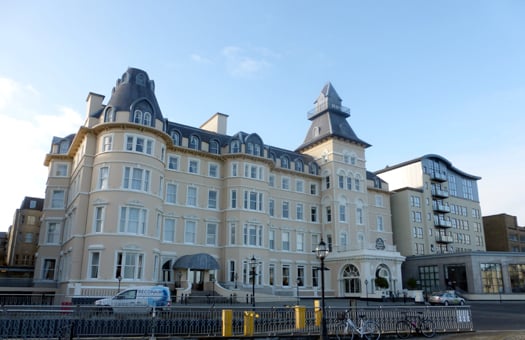
The Royal Marine Hotel has a distinctive style which unfortunately was not replicated in the extension on the right, which was added several decades ago. Photo: W M Nixon
Whatever, the Dun Laoghaire waterfront at the height of the late Victorian-Edwardian era really was quite something. There were several different styles of architecture, but mostly they were good examples of their type, and all respected each other. It had a sense of completeness which harmonised with the harbour. But since then we seem to have lost the plot. Is there an element of disliking the built symbols of the past, and therefore sticking up something which is effectively a deliberate affront?
Perhaps it's just that architects are scared stiff of being accused of producing new buildings, or extensions to buildings, which are merely pastiches of what went before, despite the fact that the general public seem more than happy with a good pastiche. And surely it's better to have a good pastiche than a bad bit of pseudo-modern design which clashes with everything about it?
Thus the harmonious Dun Laoghaire waterfront of a century ago, as seen from within the harbour or down the piers, is now giving out conflicting messages which dampen the sense of welcome for those entering the port. The stately Royal Marine Hotel, a bit pretentious in its day perhaps, but nevertheless true to itself, was given an addition on its western side which, unusually, still hasn't mellowed in – it continues to look like a bad example of architecture from a particularly poor period.
As for that wonderful Town Hall, the office block added down one side is better than the addition to the Royal Marine, but it has lost the opportunity to make a statement of harmony on the building's north side facing across to the railway station. And as for what could have been a town square in front of the Town Hall (for which we argued in favour in several issues of Afloat magazine a very long time ago) that was filled with the Pavilion Development which, while built with quality materials, has never seemed to quite know what it is supposed to be doing. You could scarcely claim it to be a runaway commercial success, and as ever in Dublin, it was the residential part of the project which provided the real motor for the exercise.
But those residential blocks in turn intruded on the vital miniature parkland and garden in front of the Royal Marine Hotel. Now that glorious sea view from the Royal Marine is being further impaired by the new library. In fact, "impaired" is scarcely the word. The Royal Marine doesn't really have a sea view any more at all, in the sense that rooms at the front had a view clear out into the open waters of St George's Channel. Strictly speaking, all that the Royal Marine can now look forward to is a harbour and bay view, which is rather different. Much better than many Dublin hotels, perhaps, but a poor thing by comparison with the wide nautical vistas of the past.

Artists's computerised impression of how the view of the Royal Marine hotel will look once the new library (left) is completed
As for this new library, doubtless in the architectural trade it will be seen as an impressive use of new materials, and it will be pointed out how skilfully it has been fitted into a narrow space. But the computer-generated impressions of the finished building show something a little too like a Belfast peace wall to bring joy to the heart, and on its east side – the hidden side looming over many residential properties – they seem to be utilising rather a lot of nasty red brick, something which is otherwise almost entirely unused anywhere else on the Dun Laoghaire waterfront.
But while the new library may seem to roar at its neighbours and loom threateningly over them, not every new development along the Dun Laoghaire waterfront provokes hostility. For instance, the new Irish lights headquarters is so good of its type that it greatly enhances the area. And as for the Ferry Terminal, "reasonably good of its sort" might be the kindest response. Something had to be provided to give a positive architectural response to the very new-style HSS ferries, and when there's one in port it's sometimes difficult to tell where ship ends and ferry terminal begins, which is as it should be.
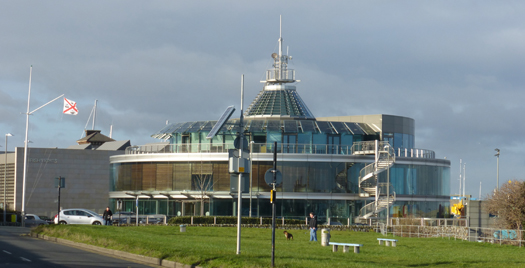
It just shows what you can do by really trying, and being brave. The impressive Irish Lights headquarters building. Photo: W M Nixon
But the era of very high speed ferries may be drawing to a close, as the shipping companies gravitate towards a new generation of ships which may not be so utterly fast, but are much quicker than the boats the HSS replaced, and provide a level of on-board comfort which makes the little extra time aboard slip easily by.
With economy measures now totally dominant, the lower berthing prices and much greater available berthing options offered by Dublin Port offset the fact the driving through the hinterland of the Port to the ferry terminals is not really a joyous urban experience. Most car-ferry passengers are prepared to tolerate a level of urban and sub-industrial blight in order to get cheap fares and frequency of service.
But where the ferries move away as they appear to be doing from Dun Laoghaire, it seems the cruise liners want to move in. The cruise liners currently can berth alongside in Dublin Port, but have to lie off in Dublin Bay if they want to send their passengers directly by tender into Dun Laoghaire. But for the cruise liners and their guests, the prospect of Dun Laoghaire becoming a proper cruise liner port is positively mouth-watering.
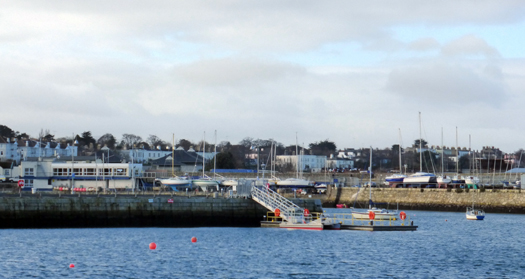
At the moment, the only access the passengers on large cruise liners have to Dun Laoghaire is via the ship's tenders to this landing pontoon in the Inner Harbour. Photo: W M Nixon
For when it fulfils its potential, Dun Laoghaire is a place of style and fun, an ideal up-market cruise liner destination. Simply being there in a luxurious cruise liner would be enough in itself on a sunny day with the harbour and waterfront alive with people enjoying themselves. And the ready access to Dublin itself, and the Garden of Ireland in Wicklow, is all a bonus.
But such perfection won't come cheap. For sure, if it comes to fruition the Dun Laoghaire Harbour Masterplan of two years ago, indicating a large cruise liner berth to the west of the present ferry terminal, would indeed provide the Harbour Company with a golden source of income. But whether that income can be transferred onwards to traders in the town is another matter.
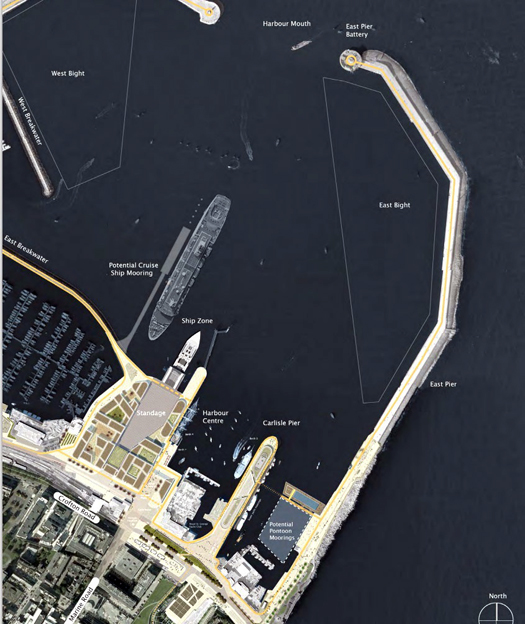
The initial plan of two years ago for a Cruise Liner berth within Dun Laoghaire Harbour. While it will restrict some sailing and boating space within the harboiur, new space will be created by the removal of the moorings in the East Pier bight. Note the proposed swimming pool indicated at the time at right angles to the East Pier off the National YC (bottom right) with marina berths within a new breakwater.
Cruise liner passengers are notorious for seeking complete packages beforehand. Thus when they arrive in port they expect shore visits to be part of the deal, and they prefer to move in pre-paid groups ashore, rather than move individually and spend some money in the town. So those who would expect across-the-board benefit may be disappointed. They may find that the cruise liner seen as the goose that lays the golden does indeed squat down, almost taking over the entire harbour, and it does indeed lay a golden egg. But that golden egg is only a fat berthing fee for the harbour company and hire fees for some bus company. Beyond that, expenditure can very limited.
Yet there's no denying the real money that be made out of berthing fees, and that of course will percolate into the town in the form of wages for extra waterfront staff. Who knows, they may even have to find a crew for a designated Dun Laoghaire harbour tug or two, though a state-of-the-art cruise liner is computer controlled by a single joystick activating thrusters working every which way, and it's amazing the spaces they can access without tugboat aid. That said, in the event of a rare summertime nor'east gale, you could sell tickets for the end of the pier to watch a giant liner getting out.
But this is all way in the future, though with every step in the economic recovery, that future is accelerating in its approach. For the moment, we can be sure that markers are being put down for future harbour use, and the word is that all the swinging moorings in the east bight of the harbour are going to be cleared, presumably to allow eventual manoeuvring space within that part of the harbour for liners. As that space will be empty when no liner is moving, its possible availability will partly compensate for the inevitable loss of sailing and boating space within the harbour, which is a proper concern of Water Wag sailors, inshore rowing clubs, and the increasing number of sailing schools.
A newer line on the grapevine has it that one of the yacht clubs outside the current marina, currently concerned about members losing those mooring in the eastern bight, has negotiated exclusive rights for its members to the stand-alone marina pontoons in the northwest part of the harbour inside the northern marina breakwater, those berths to be accessed by a regular ferry service from the club in question.
While seeing the logic of this, it would put paid to a crazy little notion of mine. Until this new allocation arose, it had seemed to me that there was potential for a completely new club, with its headquarters way down the West Pier where it meets outer marina breakwater. This new club would have its own direct access to that northwest part of the marina. The wild West Pier – which some would like to se as a kind of nature reserve – has ample room for both a roadway to this new clubhouse, and the existing walkway right out to the lighthouse. It would be one of the few clubs in Ireland to be south-facing, and its location would certainly provide that sense of being away from it all which is supposed to be what going sailing is all about.
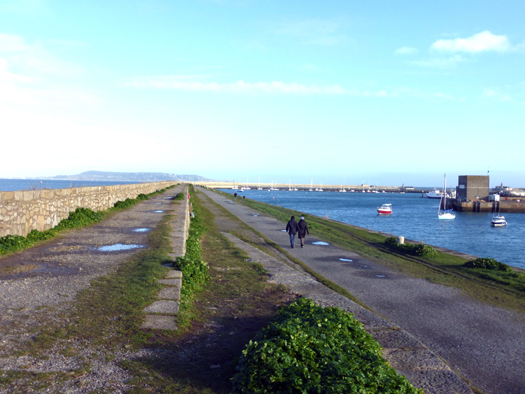
The wild West Pier. Were it needed, there is plenty of space for both a walkway and a roadway. Photo: W M Nixon
But that little daydream is now gone with the likelihood of a rapid ferry service from a club to the northwest Marina pontoons. Meanwhile, back in the real world, what is happening to preserve or destroy Dun Laoghaire's unique ambience which will, it's hoped, encourage Cruise Liner Companies to fork out mega-bucks to berth there?
If you look carefully at the Masterplan, you'll see that in front of the National YC there's a blue pool indicated at right angles to the East Pier. At the time, this was envisaged as a swimming pool and lido area in a vast barge, and it seemed a reasonable idea, as within it there were indicated new marina berths within convenient reach of the club.
But a recent planning application by the Harbour Company has put a different spin on all this. The new "urban beach" will be on a floating structure paralleling the East Pier alongside that handy berthing area on the East Pier. A cost of €2.5 million is being quoted as the capital expenditure needed to create this new facility, and the spokesmen for the harbour company are confident it will attract enough high-paying customers to pay off the initial cost while covering the significant running costs.
That's as may be, but this large intrusion into valuable berthing space is also a matter of concern for those who have been campaigning long and hard for the restoration of the nearby disused Dun Laoghaire Baths, which are outside the harbour area and therefore wouldn't reduce any valuable berthing space. But in any case they're in a deplorable state of dilapidation, a danger and an eyesore, so some action is urgently needed. There's a Public Meeting on today (Saturday January 25th) about all this in the Kingston Hotel in Dun Laoghaire at 3.0pm, and it will be interesting to hear what people think about the old baths in relation to the proposed new urban beach.
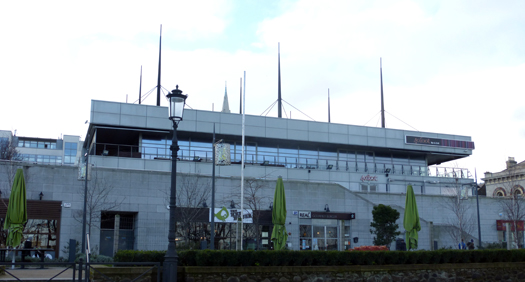
The English pub chain J D Wetherspoon have indicated their intention of opening in the former Forty Foot premises on the top of the Pavilion. Photo: W M Nixon
We move along the waterfront to the Pavilion, and the former Forty Foot pub. It's as near as certain going to be the Dublin area's first J D Wetherspoon pub. You'll have heard of them as the people in England who already have a chain of 900 pubs, and have just opened the first ever pub at motorway service area, which one would have thought unthinkable, but such seems to be the case. Anyway, big chief Tim Martin and his efficient team running this outfit have decided the time is now ripe to move into Ireland with its many post-Tiger era bankrupted bars.
And they make no secret of their intentions. Their ideal location, they say, is large premises in a strongly working class area. Good for them, you say, but who on earth reckons Dun Laoghaire to be a strongly working class area? Well, 900 successful pubs across England can't be wrong. And it could well be what the Pavilion needs to come to life, even if it's not quite what posh passengers on a cruise liner might expect. But as for resentment that an English pub chain is moving into Ireland, the reality is that your favourite local, after a tricky time emerging from the aftermath of the boom years, is now probably owned by a German bank anyway.
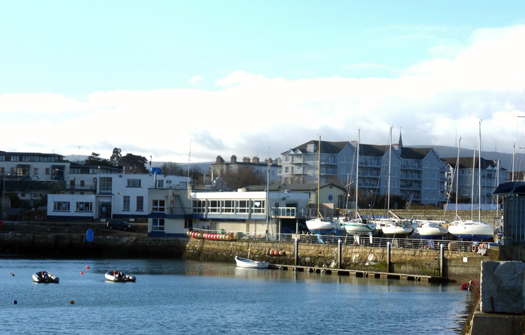
It's one very crowded little spot already. The Dun Laoghaire Motor Yacht Club, the Coastguard, and the Irish National Sailing School are among those crowded into the southwest corner of the harbour where a new Halting Site is also planned. Photo: W M Nixon
Concluding with our third opening point, the proposed new halting site towards the West Pier is a tricky one. That corner of the harbour has a small long-established site, presumably the new one will be much bigger. And things are already very crowded down there with the Dun Laoghaire Motor Yacht Club on the sea side of the little quayside street, and the premises of the Irish National Sailing School, the Irish Coastguard and others across the narrow road.
The business of Traveller Halting Sites is a difficult one, but doubtless Dun Laoghaire can cope in its own way. After all, the harbour area already has several locations which look after the needs of people who have immediate access to unexpectedly large sums of ready money, people who also have a strange taste for drinking alcohol in the open air even when the weather is atrocious, people moreover who enjoy moving about all the time in uncomfortably confined damp spaces in close proximity with like-minded ruddy-faced folk. It's just that they're not called Halting Sites. They're called Yacht Clubs.
Dun Laoghaire Harbour Company CEO Gerry Dunne responds to this article here.
Round Ireland Race Ties the Knot in Dun Laoghaire to Boost Race Numbers
#roundireland – Round Ireland race organisers have increased the maximum race entry to 100 yachts following what has been deemed 'an historic expansion' of the Round Ireland Yacht Race that will facilitate yachts of all sizes taking part, it was announced this evening in Dun Laoghaire.
As previously reported by Afloat.ie in October, Wicklow Sailing Club, which organises the race, has linked up with the Royal Irish Yacht Club to provide full pre-race management facilities in Dún Laoghaire for the larger yachts which are unable to berth in Wicklow Port. Through the introduction of a fully-equipped shore base in Dún Laoghaire, larger boats can now berth and enjoy full pre-race facilities in advance of the Race departure from Wicklow.
The Round Ireland Yacht Race is now in its 34th year and is Ireland's premier offshore sailing race attracting entrants from across Europe and as far afield as Russia, the USA and New Zealand. It will depart Wicklow on Sunday 28th June 2014 at 2.00 pm
There will be no changes to the Race itself, other than increasing the maximum number of entries from 75 to 100 yachts. Wicklow Sailing Club will continue to run the race under the auspices of the Royal Ocean Racing Club and the Race will start and finish in Wicklow.
Organisers at Wicklow Sailing Club expect that this landmark expansion of the Round Ireland through the new association with the Royal Irish Yacht Club is set to give the Race a significantly higher international profile and attract the attention of the larger, ocean racing, fleet.
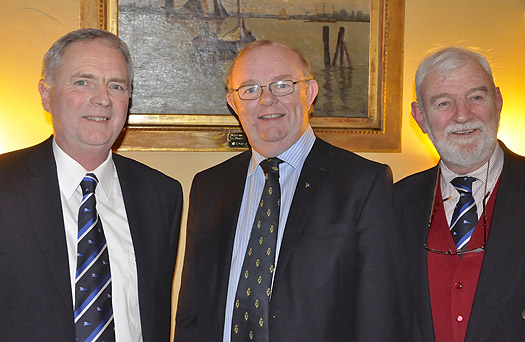
Peter Shearer, Commodore Wicklow Sailing Club, Paddy McSwiney, Commodore Royal Irish Yacht Club, and Theo Phelan, Race Organiser at the launch of the 2014 Round Ireland Yacht Race at the Royal Irish Yacht Club in Dún Laoghaire.

Theo Phelan, Race Organiser , Paddy McSwiney, Commodore Royal Irish Yacht Club, and Sadie Phelan President Wicklow Sailing Club
Race Organiser, Theo Phelan:
"Discussions on expanding the Race have been ongoing for some time arising from expressions of interest from owners of the larger offshore racing yachts seeking entry conditions to our race. Internationally, completing the race is considered a significant feat as the race is one of the most gruelling and challenging sailing competitions in the yacht racing calendar.
"The course, starting and finishing in Wicklow, brings entrants through widely different sea types and coastlines, from the Atlantic ocean to the more sheltered Irish Sea, with difficult tidal gates, particularly around the North Eastern coast and navigational challenges requiring day and night tactical decisions at every change of forecast."
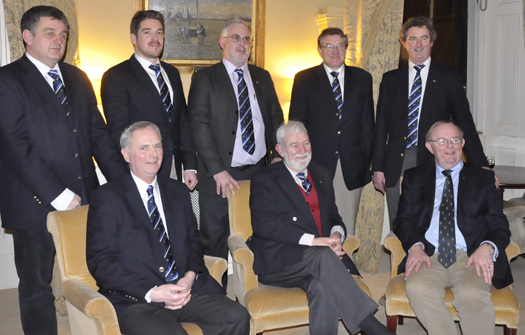
Round Ireland Race committee: (back row) David Ryan, Kevin Johnson, John Harte, John Johnson and Charlie Kavanagh (front) Peter Shearer, Commodore Wicklow Sailing Club, Theo Phelan, Race Organiser and Paddy McSwiney Commodore Royal Irish
Whilst 2014 could see an increase in larger yachts entering the Round Ireland, organisers say that the changes introduced to the management format this year should attract a significantly greater interest in entries for 2016 and subsequent events:
"Huge planning goes into preparing for this race as there are very strict qualifying criteria for crew, yachts and equipment. Knowledge of medical response, survival at sea certificates and a minimum of 300 nautical mile offshore experience are basic to entry as both crew and yacht need to be prepared for all conditions. In 1994 for example, there were 17 retirals from the Race arising from adverse weather and equipment failure. A year's planning to participate in this race would not be unusual and already there will be skippers of larger yachts putting plans in place for 2016."
The Round Ireland Yacht Race is the only RORC race based in Ireland. It is regarded as equivalent in terms of rating points to the Fastnet Race, the classic offshore race, which runs in alternate years to the Round Ireland.
In a final comment the Commodore of Wicklow Sailing Club, Peter Shearer, stated: "The endorsement of the Royal Ocean Racing Club, the largest yacht racing organisation in the world, together with the stated support of the Irish Sailing Association for our new venture bodes well for the forthcoming event in 2014 and for our endeavour to develop the full potential of the Round Ireland Yacht Race."

John Sinnott, president Wicklow Town and District Chamber of Commerce with Dutch Sailing guests Linda and Ronald Koelink
Royal Irish Yacht Club Sailors Racing in Sydney–Hobart
#rshyr– Christmas Day has come to a close on the other side of the world and for a few Irish sailors it means the last night of comfortable sleep as they are now racing in the Rolex Sydney to Hobart Race.The Irish crew consists of Barry Hurley (Skipper), Kenneth Rumball (Watch Leader), Keith Kiernan (Navigator & Radio man), Catherine Halpin (Bow-Woman) all coincidentally members of the Royal Irish Yacht Club in Dun Laoghaire. Racing on the Australian Beneteau First 40 entry, 'Breakthrough', the crew began racing this morning (26th of December) from a start inside the heads of Sydney Harbour. Race tracker here.
ICRA's 2014 national championships will be sailed under the burgee of the Royal Irish Yacht Club on Dublin Bay. The three day championships from June 13 to 15, that is expected to generate over 120 boats will support the Royal Alfred Yacht Club's (RAYC) Bloomsday regatta on June 14th. ICRA's executive committee recently announced changes for the 2014 format that will dispose of the no discard rule trialled at the 2013 event in Fenit, County Kerry. Download PDF of the 2014 Notice of Race below.
ICRA Discards 'No Discard' Rule for 2014 National Championships
#icra – The Irish Cruiser Racing Association (ICRA) executive met in Portlaoise at the end of last month and reviewed the 2013 National Championships in Fenit, Co. Kerry revealing a number of changes for the 2014 event scheduled for Dun Laoghaire.
The meeting agreed to abandon its 'no discard provision' for its national championships that was used in Kerry and revert to its earlier provision 'If 6 or more races are sailed 1 discard will apply for next year.
But there will be no change to the professional rule operating at the Fenit event and it was also agreed that the IRC rules were properly applied in Kerry and should be so applied in future.
Present in Portaoise was ICRA commodore Nobby Reilly, Mark Mills, Barry Rose, Peter Stewart, RUYC, Ed Alcock,
Simon McGibney, Fintan Cairns, Ian Travers, Chris Howard, Peadar Murphy and Denis Kiely.
ICRA is to tighen its notice and scoring rules so that clear scoring rules would be published for the future for its team event.
The question of whether a non-ICRA boat can win the National Championships was also raised and as it was an open event it was confirmed non-ICRA boats can win the title.
There was a general discussion about the Fenit event and matters such as marks visibility, abandonment of racing on the Saturday due to high winds [37kts reported] where various views were expressed. It was also agreed that there should be closer ICRA liaison with the Race Officers during the regatta.
In relation to the race schedule it was agreed that in future the general policy to be observed by race officers would be that, taking into account weather conditions, as many races as possible [3 races] would be held in the early part of the regatta i.e. every suitable opportunity to get in a race would be taken, and that the SIs should be written to reflect this policy.
After lengthy discussion, the dates agreed with the Royal Irish Yacht Club for the 2014 event - 13th to 15th June 2014 - were approved.
J/70 Sportsboat Test Sails Dates Announced for Dun Laoghaire
#J/70 – It looks like a new 'pocket rocket' sportsboat is set to enter the Irish sailing scene with news that Key Yachting Ltd (the dealer for J Boats in the UK and Ireland) is planning a J/70 Trial Sail Weekend in Dublin Bay from Friday 6th of September to Sunday 8th of September. The event will be hosted by the Royal Irish Yacht Club in Dun Laoghaire and representatives from North Sails Ireland will also be on hand throughout the weekend.
Well know sportsboat sailor Roger Bannon has already taken one for a spin and his J70 Boat Report is here.
The plan is to offer those who are interested in the J/70 the chance to sail the boat either Friday afternoon, Saturday morning, Saturday afternoon or Sunday morning
Key Yachting say they will try to ensure that we are able to accommodate as many trial sails as possible during the weekend, but promoters say it would help enormously with the planning if you could let them know when you would like to come.
If you are keen to take this super-fast sportsboat for a spin around the bay, email [email protected]
#dragon – The Irish Dragon class has been unable to commit to 'more than a handful of boats' travelling to Bangor in County Down for the 2013 Irish National Championships in August.
As a result, the class has been forced in to a change of venue and the championships will now take place at the Royal Irish Yacht Club on Dublin Bay from August 8-11. The class has an entry of nine for this week's Volvo Dun Laoghaire regatta.



























